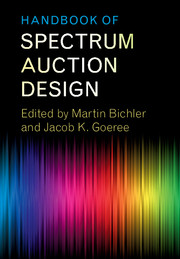Book contents
- Frontmatter
- Contents
- List of Contributors
- Preface
- List of Papers
- Part I The Simultaneous Multiple-Round Auction
- Part II The Combinatorial Clock Auction Designs
- 5 Combinatorial Auction Design
- 6 The Clock-Proxy Auction: A Practical Combinatorial Auction Design
- 7 Spectrum Auction Design
- 8 A Practical Guide to the Combinatorial Clock Auction
- 9 Market Design and the Evolution of the Combinatorial Clock Auction
- 10 Quadratic Core-Selecting Payment Rules for Combinatorial Auctions
- 11 Core-Selecting Package Auctions
- 12 A New Payment Rule for Core-Selecting Package Auctions
- 13 On the Impossibility of Core-Selecting Auctions
- 14 Ascending Combinatorial Auctions with Risk Averse Bidders
- 15 Properties of the Combinatorial Clock Auction
- 16 Budget Constraints in Combinatorial Clock Auctions
- 17 (Un)expected Bidder Behavior in Spectrum Auctions: About Inconsistent Bidding and its Impact on Efficiency in the Combinatorial Clock Auction
- Part III Alternative Auction Designs
- Part IV Experimental Comparisons of Auction Designs
- Part V The Bidders’ Perspective
- Part VI Secondary Markets and Exchanges
- Outlook
- References
5 - Combinatorial Auction Design
from Part II - The Combinatorial Clock Auction Designs
Published online by Cambridge University Press: 26 October 2017
- Frontmatter
- Contents
- List of Contributors
- Preface
- List of Papers
- Part I The Simultaneous Multiple-Round Auction
- Part II The Combinatorial Clock Auction Designs
- 5 Combinatorial Auction Design
- 6 The Clock-Proxy Auction: A Practical Combinatorial Auction Design
- 7 Spectrum Auction Design
- 8 A Practical Guide to the Combinatorial Clock Auction
- 9 Market Design and the Evolution of the Combinatorial Clock Auction
- 10 Quadratic Core-Selecting Payment Rules for Combinatorial Auctions
- 11 Core-Selecting Package Auctions
- 12 A New Payment Rule for Core-Selecting Package Auctions
- 13 On the Impossibility of Core-Selecting Auctions
- 14 Ascending Combinatorial Auctions with Risk Averse Bidders
- 15 Properties of the Combinatorial Clock Auction
- 16 Budget Constraints in Combinatorial Clock Auctions
- 17 (Un)expected Bidder Behavior in Spectrum Auctions: About Inconsistent Bidding and its Impact on Efficiency in the Combinatorial Clock Auction
- Part III Alternative Auction Designs
- Part IV Experimental Comparisons of Auction Designs
- Part V The Bidders’ Perspective
- Part VI Secondary Markets and Exchanges
- Outlook
- References
Summary
Introduction
Combinatorial auctions enhance our ability to efficiently allocate multiple resources in complex economic environments. They explicitly allow buyers and sellers of goods and services to bid on packages of items with related values or costs. For example, “I bid $10 to buy 1 unit of item A and 2 units of item B, but I won't pay anything unless I get everything.” They also allow buyers, sellers and the auctioneer to impose logical constraints that limit the feasible set of auction allocations. For example, “I bid $12 to buy 2 units of item C OR $15 to buy 3 units of item D, but I don't want both.” Finally, they can handle functional relationships amongst bids or allocations, such as budget constraints or aggregation limits that allow many bids to be connected together. For example, “I won't spend more than a total of $35 on all my bids” or “This auction will allocate no more than a total of 7 units of items F, G and H.”
There are several reasons to prefer to have the bidding message space expanded beyond the simple space used for traditional single commodity auctions. As Bykowsky et al. (2000) point out, when values have strong complementarities, there is a danger of ‘financial exposure’ that results in losses to bidders if combinatorial bidding is not allowed. For example, in the case of complementary items such as airport take-off and landing times, the ability to reduce uncertainty to the bidder by allowing him to precisely declare his object of value, a cycle of slots for an entire daily flight pattern, is obvious: one component slot not acquired ruins the value of the flight cycle. In the same situation substitution possibilities would also be important to consider: if flight cycle A is not won, cycle B may be an appropriate though less valuable substitute for the crew and equipment available. Allocation inefficiencies due to financial exposure in noncombinatorial auctions have been frequently demonstrated in experiments beginning with Rassenti et al. (1982) (see also Porter (1999), Banks et al. (1989), Ledyard et al. (2002) and Kwasnika et al. (1998)).
- Type
- Chapter
- Information
- Handbook of Spectrum Auction Design , pp. 111 - 119Publisher: Cambridge University PressPrint publication year: 2017
References
- 1
- Cited by



